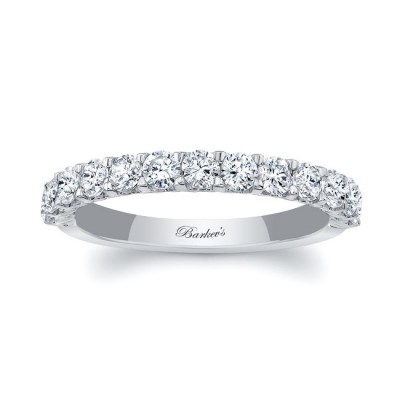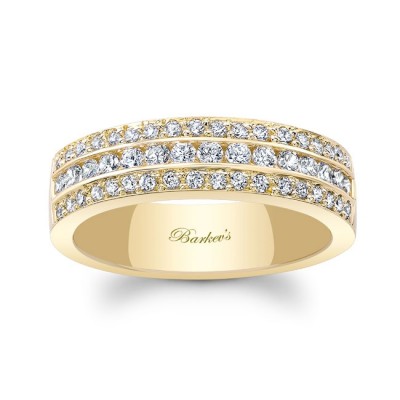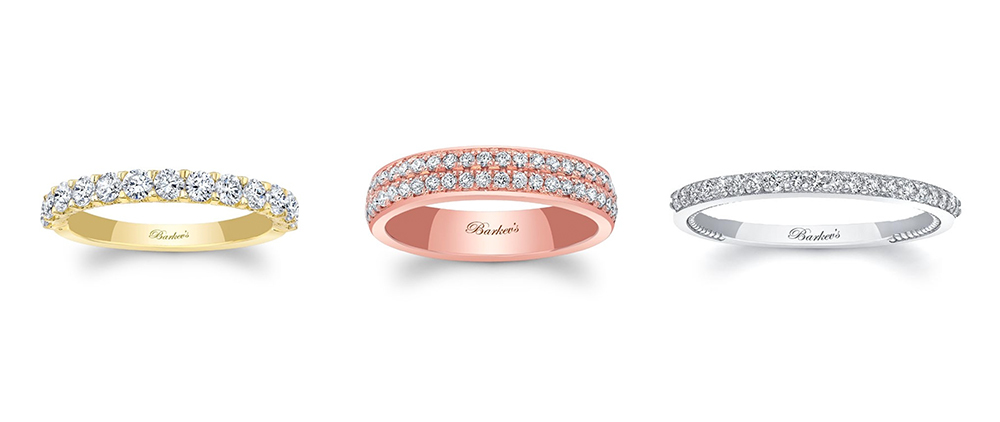Eternity bands are gorgeous, timeless, and meaningful- but is this chic style right for you? To help you decide for yourself, below, we’re answering all the most frequently asked questions about this distinctive ring design. Read on to learn everything you need to know about eternity bands.
1. What is an eternity band?
An eternity band is a ring that features a continuous circle of matching gemstones, which are usually diamonds. These gemstones create an infinite, or eternal, ring that has no beginning or end. Eternity bands are also sometimes called eternity rings, infinity rings, or full diamond bands.
2. What does an eternity band mean?
An eternity band symbolizes eternal love. This meaning is imparted by the design’s continuous ring of diamonds or gemstones. The unbroken ring symbolizes eternity, while diamonds and gemstones symbolize love.
3. When should you give an eternity ring?
An eternity ring is an expression and celebration of deep love, so giving one can be appropriate for a variety of occasions in a relationship. Most commonly, people choose to give eternity bands as milestone wedding anniversary presents and as push presents. In recent years, wearing an eternity band as your engagement ring or wedding band has also become fashionable.
4. Should I choose a full eternity ring or a half eternity ring?

The most traditional eternity band design features a full, unbroken ring of gemstones. However, a full eternity ring isn’t for everyone. Full eternity rings can be uncomfortable to some, especially when they feature larger gems. They’re also practically impossible to resize and, by nature, they’re more expensive than similar alternatives: half eternity rings and ¾ eternity rings.
Half eternity rings and ¾ eternity rings feature half or 75% as many gems as full eternity bands. Since they feature fewer gems, they’re inherently less costly than full eternity bands. Other advantages of these types of bands include the fact that they’re easy to resize and, in some cases, they can be more comfortable compared to full eternity bands. Yet, a notable disadvantage of partial eternity bands is that they tend to rotate, so your diamonds can appear off center. Some also feel that the fact that a partial eternity band has a broken ring of diamonds has a negative affect on its meaning.
As far as which of these styles is right for you, that all comes down to personal preference. Consider what you’re looking for in terms of meaning, style, and practicality, then choose accordingly.
5. What finger do you wear an eternity ring on? Should it be on your left hand or right hand?
You can wear an eternity band on any finger you like. Since eternity bands are often worn as wedding bands, engagement rings, and anniversary bands, the most common choice is the ring finger on the left hand.
6. Can you resize an eternity band?
Because full eternity bands feature a continuous ring of gemstones, it can be impossible for a jeweler to resize an eternity band while also retaining its design, beauty, and craftsmanship. Resizing is particularly impractical for eternity bands with fewer diamonds or certain types of settings, such as channel settings. Due to the exacting spacing requirements these eternity ring styles demand, it could be impossible to have them resized. Instead, they may need to be entirely remade.
Because many eternity bands often cannot be resized, it’s crucial to know the correct ring size before you purchase one. Whether you’re buying an eternity band from a jewelry store or having an eternity ring custom made, you want to get your sizing right on the first try.
7. What’s the difference between eternity rings, wedding rings, and engagement rings?
Eternity rings have a very specific design: they feature an unbroken ring of matching gemstones set along a band. Engagement rings and wedding bands, on the other hand, are defined by their meaning, rather than their design. Any type of ring, including an eternity ring, could be an engagement ring or a wedding ring depending on what it symbolizes to the wearer.
8. Which diamond shape is best for eternity bands?

The most traditional diamond shape for eternity bands is round, but other diamond shapes can also look gorgeous in an eternity setting. The parallel edges of princess cut, emerald cut, radiant cut, asscher cut, and baguette diamonds can create a seamless line of brilliance that’s absolutely stunning in an eternity band. Then, fancy shapes with rounded edges, such as oval and marquise cut diamonds, can add a romantic, distinctive quality that’s simply lovely.
9. Which metal is best for eternity rings?
Security and durability is important for an eternity ring, so you’ll want to choose a precious metal for this ring style. Platinum, yellow gold, white gold, and rose gold are all excellent options for an eternity band.
10. What setting should I choose for an eternity ring?
The best setting for an eternity band will depend on your desired aesthetic and the size of your diamonds. Pave settings are the default choice for small diamonds because they’re elegant and create a seamless look. Split prong settings and shared prong settings are classic options that both allow for lovely light entry, making them a great choice for larger diamonds. Then, for those who prefer the modern look, you can also choose a bezel set or channel set eternity band. These stylish settings allow for a bit less light entry, but are also more secure than prong settings.
11. What does “ctw” mean for a diamond eternity band?
CTW is an abbreviation for carat total weight, which is also sometimes abbreviated as CT TW. Carat total weight is a term that’s used to describe the combined carat weight of every stone within a piece of fine jewelry. For example, say you have a 2 CTW diamond eternity ring that features 20 diamonds. From this combined total weight, you can determine that the similarly sized diamonds in the piece will each weigh approximately .10 carats. Note that because eternity bands feature a collection of similarly sized diamonds rather than one prominent center stone, it’s standard for jewelers to list them with their CTW.


